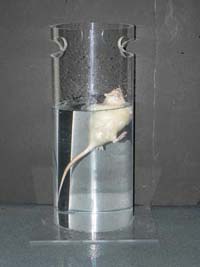
Photo from wikipedia
The forced swim test (FST) was proposed by Porsolt et al. (1977a,b) as a relatively rapid test to identify new compounds with potential antidepressant activity in rats and mice. In… Click to show full abstract
The forced swim test (FST) was proposed by Porsolt et al. (1977a,b) as a relatively rapid test to identify new compounds with potential antidepressant activity in rats and mice. In this test, the total time of immobility (TTI) was proposed as a variable that reflects despair-like behavior, which could be reduced by clinically effective antidepressants (Porsolt et al., 1977a, 1978). Since then, diverse interpretations of immobility in the FST have arisen, including behavioral despair, learned helplessness, and depression-like behavior, even considering the FST as an animal model of depression (Porsolt, 2000; Cryan and Mombereau, 2004). Immobility was interpreted as a passive coping strategy, anxiety, and psychomotor retardation or as a behavior that is related to autism spectrum disorder (Anyan and Amir, 2018; Unal and Canbeyli, 2019). A reduction of immobility in the FST by drugs was interpreted as an antidepressant-like effect because clinically effective antidepressant drugs significantly reduce this behavior (Dalvi and Lucki, 1999; Porsolt, 2000). Important discussions of the meaning and interpretation of immobility in the FST in mice and rats have occurred (Molendijk and de Kloet, 2019, 2021), questioning whether the FST should or should not be considered an experimental model of depression that reproduces in rodents the large spectrum of complex signs and symptoms that characterize clinical depression (Molendijk and de Kloet, 2021). Additionally, discussions about ethical issues related with the FST have arisen questioning its use in the preclinical research of antidepressant drugs (Reardon, 2019; Trunnell and Carvalho, 2021). The relevance of this kind of discussion highlights the following: “...we must critically assess how we are interpreting complex animal behavior to ensure we are not overly interpreting behaviors or potential missing out on alternative and fruitful direction” (Gorman-Sandler and Hollis, 2021). The present opinion article discusses how pool dimensions, among other factors, can influence the detection of immobility in the FST and how these dimensions may permit or prevent the detection of an anti-immobility effect of relatively low doses of antidepressant drugs.
Journal Title: Frontiers in Behavioral Neuroscience
Year Published: 2021
Link to full text (if available)
Share on Social Media: Sign Up to like & get
recommendations!